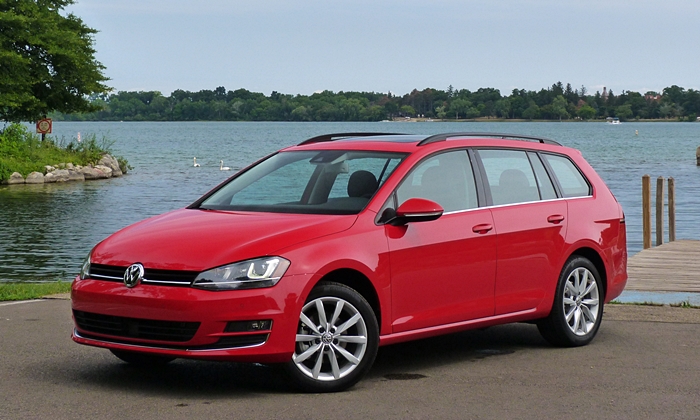Back when I was a youngster, virtually every family owned a station wagon. But the emergence of minivans and SUVs in the 1980s, following by crossovers more recently, has driven the wagon nearly to extinction in North America. Only one affordably priced conventional wagon remains, the Volkswagen Golf SportsWagen.
Despite (or perhaps because of) this long-term trend, professional car reviewers often sing the praises of wagons. If only car buyers would listen to the experts, wagons would be wildly popular.
So, who's right, car reviewers or nearly everyone else? I spent a week each with the Volkswagen Golf SportsWagen and one of the compact crossovers most popular with members, the Mazda CX-5, to discover what case might be made for the former.
Full disclosure: I've owned two quasi-wagons in recent years, a Mazda Protege5 and a Ford Taurus X.
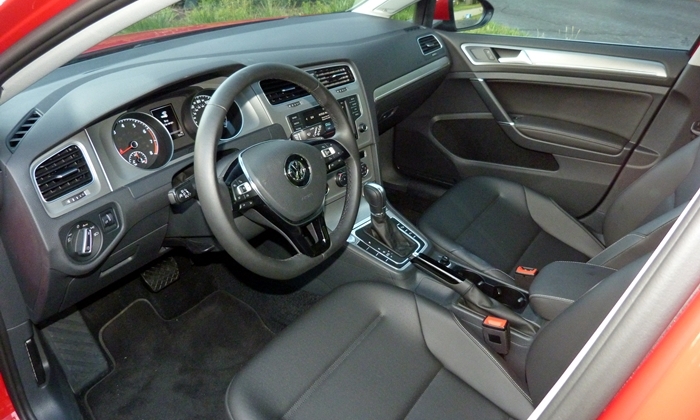
Good, clean design inside as well. Very good materials for the price, very solid.
| |
Compared to the CX-5 |
| Handling |
 Better
Worse
Better
Worse
|
Professional car reviewers keep pushing their readers to buy wagons for one basic reason: handling. Wagons aren't as tall as crossovers (or they'd be crossovers), so they have a lower center of gravity, and handle nearly identically (all else such as tires and suspension tuning being equal) to the non-wagons on which they are based. The Mazda CX-5 handles better than the compact crossovers with which it directly competes, but there's no avoiding its additional height in corners taken at speed. The Volkswagen Golf SportWagen (GSW) rolls less and feels more agile.
It helps that the car on which the Golf SportWagen is based, the iconic Golf, is arguably the best-handling compact hatchback. The latest, seventh-generation Golf handles with impressive poise and precision. It might even handle too well, in that the chassis often seems so competent and unflappable that it asks little from, and so doesn't much involve, the driver. In both hatchback and wagon forms the latest Golf could use more soul (a common complaint with the best current cars).
Also, there's such a thing as the Golf GTI to indicate what this car is capable of when properly tuned and shod with performance-oriented tires. Push the Golf SportWagen SE hard through a curve, and it feels a bit mushy as the outside front Contnental ContiProContact approaches its middling limits and scrubs. A GTI or even a GTish version of the SportWagen would fix this. Sadly, one isn't offered on this side of the Atlantic. The closest we get is the GSW SEL, which while tuned the same as the tested car has tires the same size as those standard on the GTI. As it stands, the Golf SportWagen feels supremely capable, and even athletic, but not sporty. Volkswagen could do more to press the GSW's inherent dynamic advantage over crossovers.
The Mazda also becomes less than sporty as its limits are approached, but in a different manner. The front end of the CX-5 rolls considerably more than the GSW's in hard turns, and more than it should have to, overloading the outside front tire prematurely. Perhaps this is to keep the crossover's handling extra-safe, but some crossovers maintain a more neutral disposition when pressed.
The GSW feels considerably more stable when hustled. It handles very competently. I just wish it were more engaging.
| Fuel economy |
 Better
Worse
Better
Worse
|
Compared to a crossover, a wagon should also go farther on a gallon of gas, especially on the highway, as it has a smaller frontal area to propel through the atmosphere. In the EPA's tests, the Mazda CX-5 (with front-wheel-drive) managed to slightly outscore the Volkswagen Golf SportsWagen, 26 to 25 mpg. But the GSW fares better in the highway test, 35 vs. 33 mpg.
In my real-world suburban driving, I had a much easier time getting the trip computer average over 30 mpg in the Volkswagen, and occasionally even nudged it to 40. In a couple of 70-mph highway drives the VW averaged 37 mpg, a little better than its EPA rating. The CX-5's trip computer averages were usually in the mid-20s, and sometimes in the upper 20s, but rarely got to 30. Granted, the tested CX-5 had all-wheel-drive, which likely cost it a couple mpg (24/30 in the EPA tests).
Fuel economy will also vary more with driving style in the VW, with its smaller (1.8-liter vs. 2.5-liter) but turbocharged engine. By nature turbocharged engines use less fuel when driven with a light foot, but will literally force feed themselves when asked to do so. Drive the Golf SportWagen con brio, and the trip computer average will plummet below 25. Whether you get 25 mpg or 35 mpg in the suburbs in this car really is up to you. Experimenting with various styles of driving--for science--I averaged 27.8 for the entire week.
The GSW's predecessor, the Jetta SportWagen, was powered by an engine more similiar in specification to the Mazda's, a normally aspirated 2.5 (albeit with this displacement spread over five cylinders rather than four). In the EPA's tests it managed only 23/30.
Overall, both the Volkswagen and the Mazda get excellent fuel economy for vehicles with their combination of cargo hauling capacity and performance, but the VW's lesser frontal area and smaller engine give it more upside potential.
For those desiring even better fuel economy, the Golf SportWagen used to be available with a 31/42-rated diesel engine. You've probably heard why the TDI is no longer available. While the 1.8T engine can't match the now verboten diesel's combination of low-end torque and fuel efficiency, you'll be hard-pressed to find a gasoline engine in an affordable compact that comes closer.
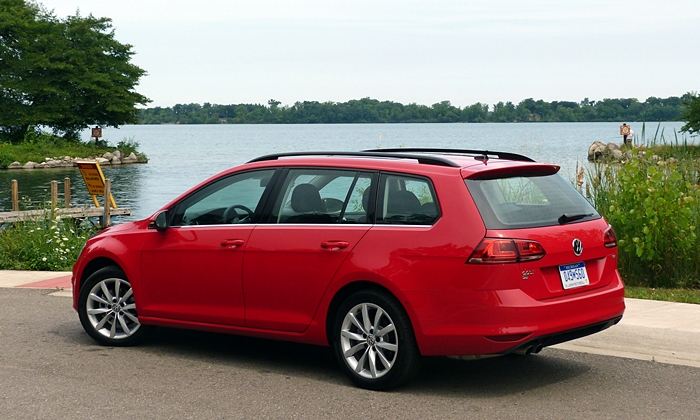
Styling to like, but not lust after, even in red.
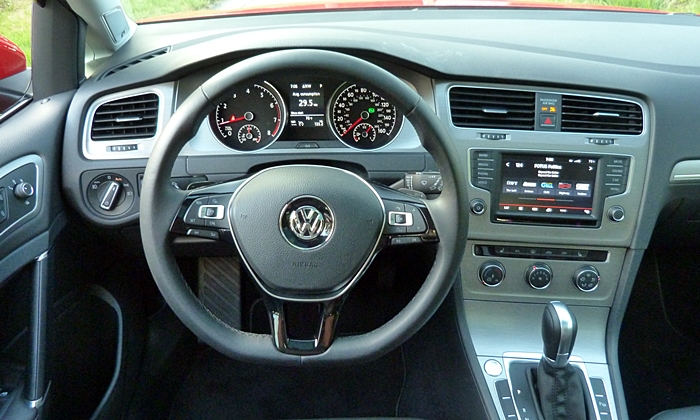
Simple, easy to reach center stack controls. But overly complicated steering wheel controls.
| Cargo capacity |
 Better
Worse
Better
Worse
|
Put another way, if you're seeking a vehicle with the handling of a well-tuned compact sedan, but that can also hold your stuff, you've come to the right place,. Compared to the Golf hatchback, the Golf SportWagen has an extra foot of length, all of it behind the rear wheel, extending the cargo floor from five feet to six. Consequently, the Golf SportWagen can hold about as much stuff as a small crossover, but without the tippy handling.
As might be expected given how the vehicles' proportions differ, the cargo space in the VW trades a few inches of height for a few inches of length. Which do you most need when carrying cargo, height or length?
One demerit: the GSW's rear seats don't quite fold flat. But they do come closer than the CX-5's.
| Front seat support & comfort |
 Better
Worse
Better
Worse
|
As I've noted before (when reviewing the e-Golf), the seventh-generation Golf's front seats are shaped and padded to provide nearly ideal comfort and support in daily driving. The CX-5's driver seat also fit me well, but not quite as well as the Volkswagen's.
Compared to other compact hatchbacks and its ancestors, the current Golf has a roomy rear seat. I can sit behind my 5-9 self with about five inches of air ahead of my knees. Unless unusually tall people populate both rows, the amount of space should be beyond adequate.
Compare the Golf SportWagen's rear seat to that in the CX-5, and a funny thing happens. On paper, the Mazda provides about 3.5 more inches of legroom. When sitting behind myself in both vehicles, though, I had about half as much space ahead of my knees in the CX-5. I've noticed in the past that VW measures rear legroom very conservatively, and apparently they continue to do so. The Golf's interior is roomier than the official specs suggest. Plus its rear seat passengers get air vents. The Mazda's do not.
This said, I'm not entirely comfortable in the Golf SportWagen's rear seat. To me it feels overly reclined. In neither the GSW nor the CX-5 is the degree of recline adjustable. It is in some compact crossovers.
| Audio & nav systems |
 Better
Worse
Better
Worse
|
Even after the Volkswagen Golf's 2015 redesign, its infotainment system remained well behind the rapidly advancing industry norm. For 2016 this has been rectified. Volkswagen's new system is among the first to support both Apple CarPlay and Android Auto, such that the car's controls and center stack display serve as an extension of your phone.
I didn't find Android Auto as easy to configure as in other cars. For some reason the system defaulted to Mirrorlink (a third system that works with both types of phones). It took a little digging through the menus, but I figured out how to get it to connect to my phone using Android Auto instead. (Few other systems offer both Mirrorlink and Android Auto, so they avoid this problem.)
Once I had Android Auto operating, its seamlessness surprised me. On my home computer, where I'm usually logged into Gmail, I had Googled directions to an unfamiliar location. Then, when I got into the Golf SportWagen and hooked up my phone, the system asked me if I wanted to go to the destination I'd just searched--on a different device, without realizing this information would carry over to the car without any explicit instruction.
My teenage son was not surprised. "It's all Google." They keep track of everything you do. For you. So they can help.
If you'll generally be driving where you have a cell connection, and your plan includes a sufficient amount of data, you'll feel the need for a nav system built into the car. (One is standard on the GSW SEL, a level up from the tested SE.)
Mazda's infotainment system doesn't yet support Apple Carplay or Android Auto. By choice. They think their own system works plenty well, and as proprietary systems in affordably priced cars go, Mazda's is a very good one. The knob-based interface is easier to use while driving than the VW's touchscreen. Also, Volkswagen has added so many tasks to the Golf's steering wheel controls that it took me a while to figure out how to do some things. The Mazda's controls remain more intuitive.
Both audio systems, Fender in the Volkswagen, Bose in the Mazda, sound very good for cars in this price range. If you prefer your music heavy on the bass, though, the Fender system readily pumps out much more of it. (I sometimes felt the need to turn the bass down.)
| |
Compared to the CX-5 |
| Reliability & durability |
 Better
Worse
Better
Worse
|
You might have heard horror stories from Volkswagen owners. Most such stories involved cars from the late 1990s and early 2000s. Volkswagens have become considerably more reliable since then, with the cars from the late 2000s onward about average or even a bit better for the first four to six years of ownership (after which they do tend to take a turn for the worse).
This said, Golfs with the 1.8T engine have been a little troublesome during the first year of ownership. Looking at the repairs behind the stats, most don't involve the engine, so it's not clear why they affect cars with the 2.0T engine less often. The glitches seem to pop up early in the cars' ownership, then taper off, as the 2015s have looked much better than earlier in recent updates. The 2016s, in the red zone as I write this, could similarly improve. (If you're reading this after November 2016, check the latest stats.)
At the moment I don't see much cause for concern with the Golf. But Mazdas in general and the CX-5 in particular have had less variable records, so for those who are especially risk-averse they're more comfortable bets.
| Exterior styling |
 Better
Worse
Better
Worse
|
To my eyes, the latest Volkswagen Golf is the most attractive to date. The wagon shares the hatchback's clean lines.
But while the Golf's exterior has become more elegant while remaining faithful to the iconic original, it remains far from exciting. Volkswagen manages to make the GTI appear sporty through its trim and wheels, but they've taken no such steps with the regular Golfs. Despite its name the SportWagen doesn't appear sporty.
This isn't the fault of the body style; once-staid Volvo offers wagons sexy enough to make haters forget their hate. The Golf SportWagen could have similarly induced "gotta have it" reactions among people who otherwise would not have considered a wagon, but will not.
Some compact crossovers also excite the eye more than others. Mazda shows how its done with the CX-5's curves, lower body side trim, and wheels. Both of the tested cars were red. The CX-5 wears its red much better.
Both cars have well-styled, well-appointed interiors (for the price range), but here as well the Mazda's styling is more overtly sporty, and more visually interesting. A proper heir to Bauhaus, Volkswagen rarely strays from good, clean design, and good, clean design (with superior materials and workmanship) is what you'll find inside the GSW. Color choices are limited to black and beige. Want bits of red here and there to spice things up, or perhaps some snazzy plaid seats? Then you'll have to get the GTI hatchback.
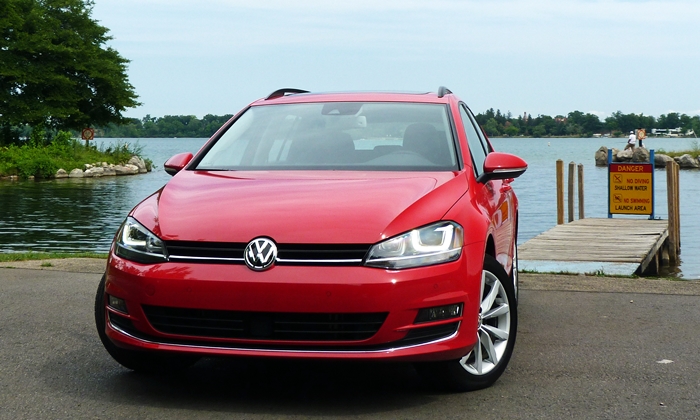
If you want a big grille, get an Audi. Optional LED headlamps.
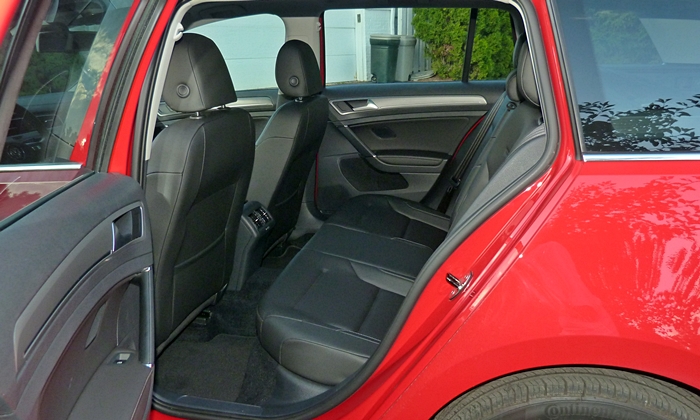
VW measures rear legroom very conservatively. There's more here than the spec suggests.
| |
Compared to the CX-5 |
| Powertrain performance |
 Better
Worse
Better
Worse
|
If you think "rocket" when you hear "turbo," the 170-horsepower 1.8-liter engine in the Volkswagen Golf SportWagen might disappoint you. The powertrain seems tuned for fuel economy, with boost coming on very smoothly (no kick or rush), the throttle reluctant to speed things up, and the six-speed automatic transmission preferring to upshift sooner rather than later. Dig you spurs in, and the transmission will downshift and the engine will come more alive, but then the steering gets a little squirrelly, feeling light and less certain of its direction. I was surprised by this, as the similar (but more firmly tuned) suspension in the more powerful GTI has no such trouble routing power through the front wheels. The message from the GSW: it can rush, but would prefer not to.
With all-wheel-drive, the tested CX-5 had no trouble transferring its 184 horsepower to the pavement. Mazda's automatic transmission is also among the most responsive. Still, you'll find few thrills by gunning it. From my notes: "Decent power in typical driving, but doesn't feel strong when rushed." Like Volkswagen, Mazda could offer the CX-5 with a more powerful engine (in this case the turbocharged 2.5-liter from the new CX-9), but so far has opted not to.
Perhaps few people are looking for thrilling acceleration in such vehicles? If your interest in acceleration is purely practical, both the Golf SportWagen and Mazda CX-5 can get to 60 mph in about eight seconds, easily quick enough for 99 percent of real-world driving.
| Ride smoothness |
 Better
Worse
Better
Worse
|
The Volkswagen Golf SportWagen's suspension absorbs large bumps very well, but can feel a touch stiff over the small stuff. I didn't experience the latter in the e-Golf. Blame is probably due a combination of the GSW's lighter unloaded weight and greater cargo capacity. Volkswagen might have tuned the wagon to ride well when loaded, such that the tuning isn't quite right with only a driver aboard.
The Mazda CX-5 rides well for a compact crossover with sporty pretensions, but as with handling physics can't be overcome entirely. A higher center of gravity has an impact. To similarly limit roll in turns, a crossover's suspension must be stiffer than a wagon's. Over bumpy roads the Mazda doesn't ride as steadily or as smoothly as the Volkswagen, and it feels at least as jiggly as the GSW over the small stuff.
Noise levels are moderate in both cars.
| Safety & braking |
 Better
Worse
Better
Worse
|
Both the Volkswagen Jetta SportWagen and the Mazda CX-5 aced their IIHS crash tests. Both also offer a full array of safety tech (adaptive cruise, forward collision warning with automatic braking, lane departure warning, blind spot warning), something you couldn't find in any car at this price until recently.
While the Volkswagen's tech package (on the tested car) includes more features than the Mazda's (lane departure prevention, obstacle detection front and rear, and semi-automated parking), its auto-braking system only operates at relatively low speeds. In the IIHS's 25 mph test, Volkswagen's system did nothing, while Mazda's system completely stopped the vehicle. While forward collision warning alone will often be sufficient to prevent an accident, I know which I'd rather have my teenage kids driving.
I'd like to see both makes offering these tech packages in lower trim levels, as Honda and Subaru have started doing. Instead, VW seems to be heading in the opposite direction. With the 2016 you could get the full safety tech package on the mid-level SE (as tested), and a partial safety tech package including the forward collision warning and blind sport warning was standard on a $25,815 "Limited Edition." VW apparently didn't get the memo that auto companies rarely take "limited" literally, and it truly was limited. For 2017 it's gone, plus only the partial package is available on the SE, and then only on "sold orders" (meaning you aren't likely to find a car so equipped on a dealer lot). For the full safety tech package in a 2017 GSW you'll have to step up to the $30,790 SEL. Maybe you wanted the SEL's standard nav, automatic climate control, and power driver seat anyway?
| Feature availability |
 Better
Worse
Better
Worse
|
Through 2016, one big difference between the Golf SportWagen and compact crossovers was that you couldn't get all-wheel-drive on the former. For 2017, though, this is changing. All-wheel-drive will be optional on the base trim Golf SportWagen and standard on the new Golf Alltrack. Think GSW with the Subaru Outback treatment: raised suspension, lower body side cladding. While I've been hoping that they'd offer the wagon in a sportier, more GTI-like form, Volkswagen has followed the market in a different direction. My fear: as with the Audi A4 avant, Subaru Legacy wagon, and Volvo V70, the crossoverized variant will cannibalize so many sales from its progenitor that the conventional wagon will be discontinued in North America.
While I'm swimming upstream, I might also mention that I'd like to see a manual transmission offered in more than the base trim level, where you can't get the nifty infotainment system or safety tech package, or even the nice big panoramic sunroof standard in the SE and SEL. (Don't want any sunroof? Well, there's always the base car.) Mazda similarly restricts a manual transmission to the CX-5's base trim level, with its smaller engine, unsportily small wheels, and limited feature set. A few people other than me might care.
An omission more people will care about: unlike with the CX-5, you cannot get the Golf SportWagen with leather upholstery. Synthetic "leatherette" often passes for the real thing these days, but not in Volkswagens, where it still feels rubbery. I don't doubt the GSW's seat upholstery will prove durable, but it neither looks nor feels upscale.
| Price or payments |
 Better
Worse
Better
Worse
|
Equipped with the aforementioned $1,495 Driver Assistance Package and the $995 LED headlights, the tested 2016 Volkswagen Golf SportWagen SE listed for $30,335. A Mazda CX-5 Grand Touring with its optional tech packages (but without AWD) lists for $32,125. A little more, but you also get some additional features, most notably nav, automatic climate control, a power driver seat, and leather. You can get all save the last on the GSW by stepping up to the SEL but then the price is $32,695--a few hundred more than the Mazda's. Overall, they're close enough that I can't see list price being a deciding factor.
But these are list prices, not typical transaction prices. You're much more likely to pay close to list price for the Mazda, given strong sales for the CX-5 and VW's recent troubles.
But even this is only how much you pay initially. Long term, resale value will matter, and the Mazda will likely hold its value better.
So, which is the better value? Probably the Mazda, but the Volkswagen Golf SportWagen also offers a lot for what it costs.
The Volkswagen Golf SportsWagen makes a great deal of sense. You get the latest safety and infotainment tech in a car with the utility of a crossover, but with more agile handling, a more stable ride, and superior highway fuel economy, at a very reasonable price. I personally like wagons--many auto writers do--and there's a lot to like in this one.
Crossovers' greatest advantage: they appeal more strongly to the emotions, especially when they're styled as sportily as the Mazda CX-5. Volkswagen might have countered this by offering their wagon in something like GTI form, with a powerful engine, aggressively tuned suspension, and sporty styling bits, but they opted not to. Instead, for 2017 they're going to offer the Golf Sport Wagen hiked up and styled to look more like a crossover. This will sacrifice some of the car's handling advantage, and add to its price. But Audi, Subaru, Volvo, and others have proven that this is what the market wants.
Hopefully most of the new Golf Alltrack's sales won't come at the expense of the regular wagon. If they do, the Golf SportWagen's days in North America could be numbered. If you want a real wagon for less than $35,000, get one while there's still one (and there isn't currently another) to buy.
Still prefer a compact crossover after reading this review? Then the Mazda CX-5 has the styling, handling, comfort, and reliability to rank among the best with affordable price tags. I'd personally prefer sharper, more agile handling, but for those seeking a modestly sportier Honda CR-V it's the one to get. I'm not surprised it's among the models most commonly purchased by TrueDelta's members.
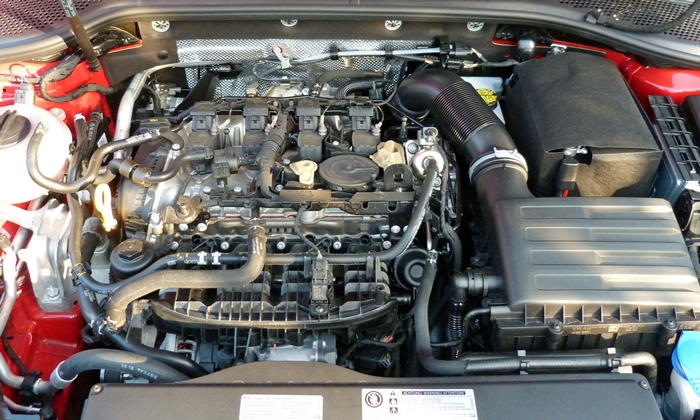
The cover hides a swarm of vacuum lines. Future sources of engine lights? Turbo behind the engine.
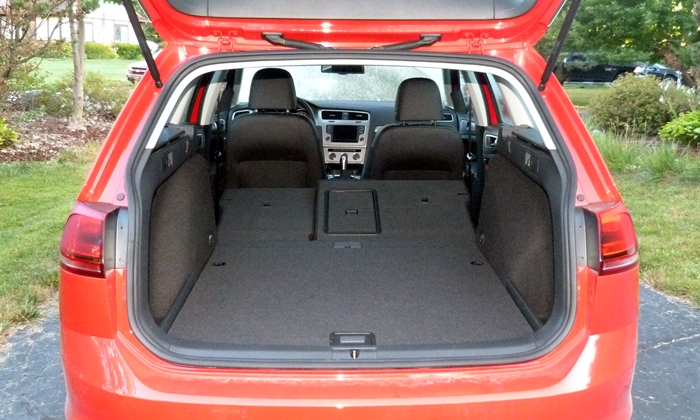
Six feet of floor with the seats folded, a couple inches more than in the CX-5.
See more 2016 Volkswagen Golf / GTI photos
VW and Mazda each provided an insured car for a week with a tank of fuel.


